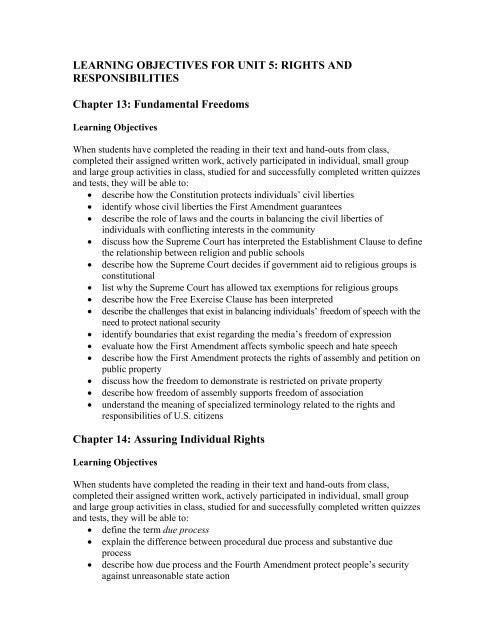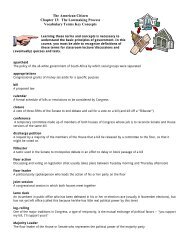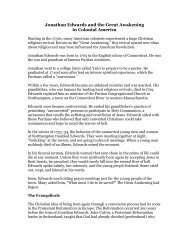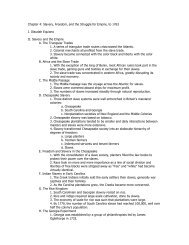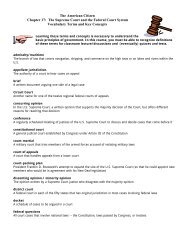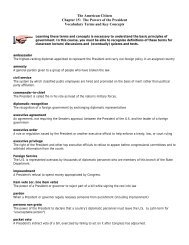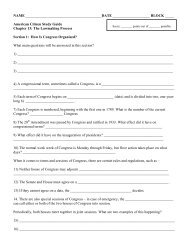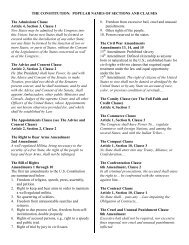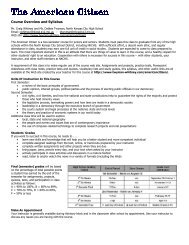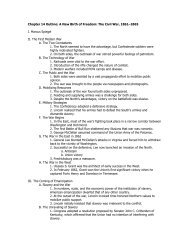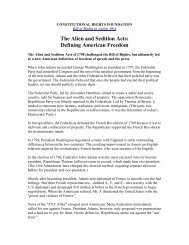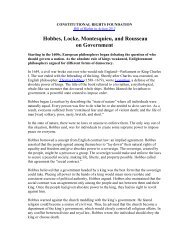learning objectives for unit 4: rights and responsibilities - Twyman ...
learning objectives for unit 4: rights and responsibilities - Twyman ...
learning objectives for unit 4: rights and responsibilities - Twyman ...
You also want an ePaper? Increase the reach of your titles
YUMPU automatically turns print PDFs into web optimized ePapers that Google loves.
LEARNING OBJECTIVES FOR UNIT 5: RIGHTS ANDRESPONSIBILITIESChapter 13: Fundamental FreedomsLearning ObjectivesWhen students have completed the reading in their text <strong>and</strong> h<strong>and</strong>-outs from class,completed their assigned written work, actively participated in individual, small group<strong>and</strong> large group activities in class, studied <strong>for</strong> <strong>and</strong> successfully completed written quizzes<strong>and</strong> tests, they will be able to:• describe how the Constitution protects individuals’ civil liberties• identify whose civil liberties the First Amendment guarantees• describe the role of laws <strong>and</strong> the courts in balancing the civil liberties ofindividuals with conflicting interests in the comm<strong>unit</strong>y• discuss how the Supreme Court has interpreted the Establishment Clause to definethe relationship between religion <strong>and</strong> public schools• describe how the Supreme Court decides if government aid to religious groups isconstitutional• list why the Supreme Court has allowed tax exemptions <strong>for</strong> religious groups• describe how the Free Exercise Clause has been interpreted• describe the challenges that exist in balancing individuals’ freedom of speech with theneed to protect national security• identify boundaries that exist regarding the media’s freedom of expression• evaluate how the First Amendment affects symbolic speech <strong>and</strong> hate speech• describe how the First Amendment protects the <strong>rights</strong> of assembly <strong>and</strong> petition onpublic property• discuss how the freedom to demonstrate is restricted on private property• describe how freedom of assembly supports freedom of association• underst<strong>and</strong> the meaning of specialized terminology related to the <strong>rights</strong> <strong>and</strong><strong>responsibilities</strong> of U.S. citizensChapter 14: Assuring Individual RightsLearning ObjectivesWhen students have completed the reading in their text <strong>and</strong> h<strong>and</strong>-outs from class,completed their assigned written work, actively participated in individual, small group<strong>and</strong> large group activities in class, studied <strong>for</strong> <strong>and</strong> successfully completed written quizzes<strong>and</strong> tests, they will be able to:• define the term due process• explain the difference between procedural due process <strong>and</strong> substantive dueprocess• describe how due process <strong>and</strong> the Fourth Amendment protect people’s securityagainst unreasonable state action
• explain how the Bill of Rights protects the people’s right to privacy• explain how the Constitution protects the right of habeas corpus <strong>and</strong> protectsagainst bills of attainder <strong>and</strong> ex post facto laws• describe how requirements <strong>for</strong> bringing charges be<strong>for</strong>e gr<strong>and</strong> juries protect the<strong>rights</strong> of people accused of crimes• describe how the Fifth Amendment protects against self-incrimination• explain how the Bill of Rights helps to guarantee the right to a fair trial• list <strong>and</strong> describe the ways that the Bill of Rights protects convicted criminals fromexcessive punishments• underst<strong>and</strong> the meaning of specialized terminology related to assuring theindividual <strong>rights</strong> of U.S. citizensChapter 15: Protecting Civil RightsLearning ObjectivesWhen students have completed the reading in their text <strong>and</strong> h<strong>and</strong>-outs from class,completed their assigned written work, actively participated in individual, small group<strong>and</strong> large group activities in class, studied <strong>for</strong> <strong>and</strong> successfully completed written quizzes<strong>and</strong> tests, they will be able to:• describe the <strong>responsibilities</strong> of citizenship• list the two ways a person may become a U.S. citizen by birth• describe how an immigrant can become a U.S. citizen• describe how U.S. immigration policy has changed over the years.• discuss the ways in which the United States is an ethnically diverse nation• list the benefits <strong>and</strong> challenges of diversity in the United States• list the two tests used by the federal courts to determine whether laws uphold theEqual Protection Clause.• discuss how the Equal Protection Clause helped the civil <strong>rights</strong> movement fightgovernment discrimination• discuss how civil <strong>rights</strong> laws have protected the equal <strong>rights</strong> of African Americans• describe how civil <strong>rights</strong> protections have been extended to other minority groups.• underst<strong>and</strong> the meaning of specialized terminology related to protecting the civil<strong>rights</strong> of U.S. citizens


